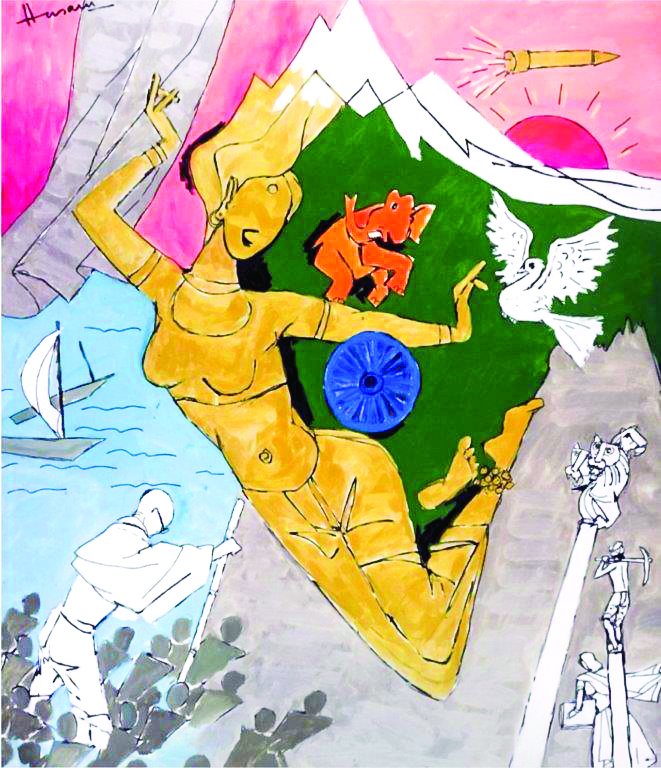As India’s foremost modernist artist, Maqbool Fida Husain’s illustrious career marked a seminal moment in modern Indian art. To celebrate this, DAG has launched a new exhibition titled ‘Husain: The Timeless Modernist’, on the heels of their Mumbai presentation ‘Master Maqbool’ in 2022. This new exhibit celebrates Husain’s six decade-long practice across varied themes.
“Husain: The Timeless Modernist’ features a collection that translates every phase of Husain’s artistic journey from the 1950s to the 2000s and reflects on his everlasting impact on the world of art,” explains Ashish Anand, CEO and MD of DAG. The exhibition opened on 26 October at DAG, New Delhi with 116 works on display. “We have included depictions of women as mythological, historical and everyday beings; focussed on his fascination with horses – rooted in childhood experiences and observations of India’s culturally diverse practices; as well as drawings and paintings that explore the idea of nationhood; and portraits and self-portraits that reflect his larger-than-life social persona.”
Anand adds, “In an effort to decode as well as pay tribute to the master, ‘Husain: The Timeless Modernist’ highlights Husain’s dynamism and versatility as an artist who embraced all forms of art, including cinema.” Hence, the works on display range from toys and sculptures to acrylic sheets used as props for his film sets. There are also rare editions of photographs taken in Madras titled ‘Culture of the Streets’ apart from paintings from different periods of his practice. Shining a light on other aspects of his personality are archival materials like his poetry manuscripts from the late 1950s, exhibition invitations and preparatory drawings.
Anand notes, “There is not much I can say about M. F. Husain that hasn’t already been said. A true and everlasting icon, he needs no further laudatory words. Husain’s larger-than-life persona was matched by the deep relationships he formed throughout his career. His approachability and accessibility made him a much-loved figure, not just among art connoisseurs but also the common man – all of whom shared an interest in his life as much as in his art. His eccentricities – such as walking barefoot, live painting performances at classical concerts, his practice of painting in homes he visited, hotels he stayed at, restaurants he ate in – added to his unique and charismatic personality. This persona, perhaps a conscious construct, complemented his iconic art. However, despite his profound contributions to Indian art and culture, he faced significant adversity towards the end of his life. Persistent threats from political entities forced him into self-exile, and he yearned to return to his homeland. DAG has been waiting a long time to dedicate a comprehensive exhibition to the legendary Husain and with this we have honoured our pledge”.
As with all their exhibitions, DAG has released an accompanying publication which offers nuanced perspectives on the artist through essays by scholars and historians. There is an overview of Husain’s work by Dr. Rakhee Balaram which explores the influence that geometry had on his creations including women, gods and goddesses, village or city settings, and horses. “Dr. Balaram shows how Husain’s oeuvre was shaped by his upbringing, the cultural syncretism he observed around him, and his constant experimentation with material choices,” shares Anand. Dr. Sumathi Ramaswamy focusses on Husain’s depiction of Mahatma Gandhi and his vision of the nation-state. Anand explains, “She explores Husain’s secular approach to spirituality, reflecting the philosophies and teachings of various religious traditions of India.” Ina Puri speaks of her relationship with Husain and his connection to her home city of Kolkata.
Divided into six sections, the exhibition attempts to present Husain, the painter and artist in a comprehensive manner. The first section, ‘Idea of a Nation’, pays ode to Husain’s love for his country. His work here celebrates Indian history and culture by capturing its many colours, myths, symbols, rhymes and rhythms in expressive lines and cubist forms. The inspiration behind these works is his childhood exposure to traditions such as the Ramayana and the Mahabharata, Ramlila and Muharram processions, which formed his syncretic Indian identity.
‘Deciphering Desire’, the second section, is dedicated to his female muses from all walks of life, including his late mother, depicted draped in a Maharashtrian saree, as well as figures from mythology, public figures like Mother Teresa and movie stars like Madhuri Dixit.
“’In Freedom of Form’, the focus is on his poetry manuscripts and line drawings – written in the 1950s in Bombay and London – which are a testament to the power of his words and lines. Cinema, too, was a significant part of Husain’s life. From starting his artistic journey painting Bollywood billboards in Bombay to making award-winning documentaries and popular feature films, Husain’s art was steeped in the language of cinema,” explains Anand.
‘Equine Elegance’ captures Husain’s passion for horses from a young age, honed by his exposure to a farrier’s workshop, the papier-mache Duldul of Muharram processions and the paintings of Chinese masters Qi Baishi and Xu Beihong. Anand surmises, “His lifelong fascination was an ode to the grace and power of horses in paintings depicting their boundless energy and fluid movements.”
‘Conversations and Connections’ shines a light on Husain’s exploration of portraiture where he captured the essence of his subjects ranging from well-recognised national icons to the distinctive personalities of his patrons. His self-portraits explored his identity as an artist, serving as a visual diary documenting the varied emotional and creative phases of his life.
Lastly, ‘Monochrome Musings’ is dedicated to Husain’s line drawings and monochromatic sketches. Anand recalls, “He was known for creating quick sketches on any available surface that was at hand, from restaurant tabletops, napkins, to margins of newspapers, capturing moments, people and places with immediacy and fluidity.”
This exhibition, on view till December 7, offers a comprehensive understanding of the way Husain’s artistic practice evolved over time, and is therefore a must visit.
Noor Anand Chawla pens lifestyle articles for various publications and her blog www.nooranandchawla.com.

